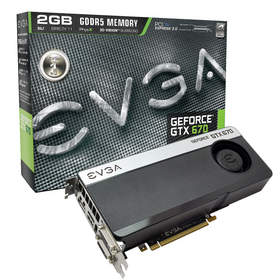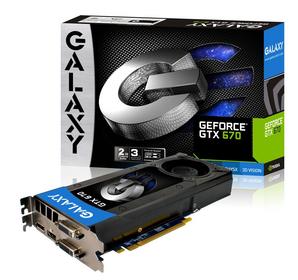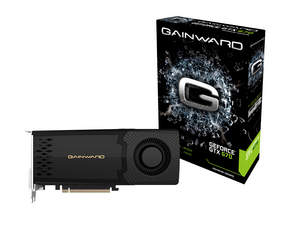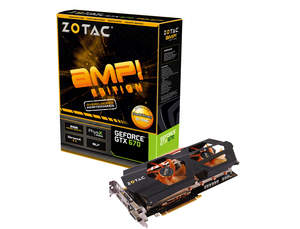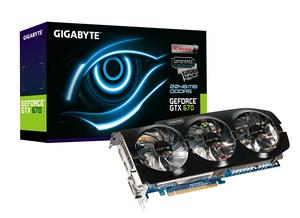SANTA CLARA, CA--(Marketwire - May 10, 2012) - NVIDIA today launched the third GPU based on its next-generation Kepler™ graphics architecture, the GeForce® GTX 670, which brings dramatically improved levels of price-performance, power efficiency and whisper-quiet operation for PC gamers, starting at $399 USD.
Engineered from the same DNA as the recently announced GTX 680 -- NVIDIA's top-of-the-line, single-GPU -- the GTX 670 packs a mean punch in its lithe 9.5-inch-long frame. It outpaces the closest competitive product in gaming performance by upwards of 45 percent,(1) while consuming approximately 18 percent less power.(2)
Plus, the GeForce GTX 670 ties the competition's much higher-priced flagship product on 25 of the world's most popular games and benchmarks, a testament to the overall performance efficiency of the Kepler architecture.
The GTX 670 is built using NVIDIA's 28-nanometer Kepler architecture, as are the GTX 680 and dual-GPU GTX 690, which were introduced in March and April, respectively.
Availability
The NVIDIA GeForce GTX 670 GPU is available now from the world's leading add-in card suppliers, including ASL, ASUS, Colorful, ECS, EVGA, Gainward, Galaxy, Gigabyte, Innovision 3D, Jetway, Leadtek, MSI, Palit, Point of View, PNY, Sparkle and Zotac.
More information about the GeForce GTX 670 is available from www.GeForce.com. For more NVIDIA news, company and product information, videos, images and other information, please visit the NVIDIA newsroom. You can also access GTX 670 product photos from the NVIDIA Flickr page located at: www.flickr.com/nvidia
About NVIDIA
NVIDIA (
(1) Games/benchmarks tested included: StarCraft II run at a full screen 19x10 resolution with "Ultra" graphics settings; Unigine Heaven 3.0 run at 19x10 resolution with 1x/1x graphic settings; and Dirt 3 run at 19x10 with 1x1x graphics settings. Graphics driver for all tests were AMD Catalyst 12.4 for the AMD HD Radeon 7950 and NVIDIA 301.34 for GTX 670. In StarCraft II, the Radeon 7950 scored 93.2fps while the GTX 670 scored 137.9fps. In Unigine Heaven 3.0, the Radeon 7950 scored 41.1fps while the GTX 670 scored 62.3fps. In Dirt 3, with DX11 enabled, the Radeon 7950 scored 81.7fps while the GTX 670 scored 117.4fps.
(2) Comparing TDP of 200 watts for the HD 7950 versus the 170 watts consumed by the GTX 670.
Certain statements in this press release including, but not limited to statements as to: the impact, availability and benefits of the GeForce GTX 670 GPU; and the effects of the company's patents on modern computing are forward-looking statements that are subject to risks and uncertainties that could cause results to be materially different than expectations. Important factors that could cause actual results to differ materially include: global economic conditions; our reliance on third parties to manufacture, assemble, package and test our products; the impact of technological development and competition; development of new products and technologies or enhancements to our existing product and technologies; market acceptance of our products or our partners products; design, manufacturing or software defects; changes in consumer preferences or demands; changes in industry standards and interfaces; unexpected loss of performance of our products or technologies when integrated into systems; as well as other factors detailed from time to time in the reports NVIDIA files with the Securities and Exchange Commission, or SEC, including its Form 10-K for the fiscal period ended January 29, 2012. Copies of reports filed with the SEC are posted on the company's website and are available from NVIDIA without charge. These forward-looking statements are not guarantees of future performance and speak only as of the date hereof, and, except as required by law, NVIDIA disclaims any obligation to update these forward-looking statements to reflect future events or circumstances.
© 2012 NVIDIA Corporation. All rights reserved. NVIDIA, the NVIDIA logo, GeForce, and Kepler are trademarks and/or registered trademarks of NVIDIA Corporation in the U.S. and other countries. Other company and product names may be trademarks of the respective companies with which they are associated. Features, pricing, availability, and specifications are subject to change without notice.
